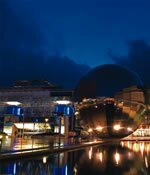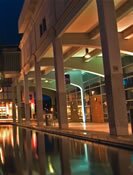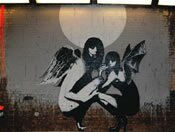Inflight Magazine of Brussels Airlines
Welcome to the Inflight Magazine of Brussels Airlines
City of ideas
Image Getty Images
When British urban music exploded in the mid 90s, Bristol was at the epicentre. Ten years on, it’s found itself in the cultural vanguard once again. Beatrice Galilee reports
 Beneath the bedroom windows, on top of brick walls, along the bottoms of industrial buildings and throughout the cobbled streets of Bristol, cultural tourists seek out the work of one of the most famous graffiti artists in the world. Once renowned as an industrial port, the city has become a canvas for Banksy’s sharply conceived, delicately stencilled artwork.
Beneath the bedroom windows, on top of brick walls, along the bottoms of industrial buildings and throughout the cobbled streets of Bristol, cultural tourists seek out the work of one of the most famous graffiti artists in the world. Once renowned as an industrial port, the city has become a canvas for Banksy’s sharply conceived, delicately stencilled artwork.
Having started out as a street artist in the late 80s, Banksy can now sell his work for hundreds of thousands of euros in galleries around the world. And, despite the fact that he has peppered walls everywhere with stylised silhouettes and political statements, even managing to tag the Palestinian–Israeli border, he has always remained anonymous. Two months ago, he was allegedly unmasked by a British newspaper. Typically, he met their claim with silence.
Banksy was part of what became known in the 90s as ‘Bristol sound’, a musical movement that saw groups and artists collaborate, spawning one of the city’s most famous exports, trip hop – a moody, down tempo take on US hip hop, popularised by groups like Massive Attack and Portishead.
 It’s still what many people associate with Bristol but, a decade on, the city’s strong artistic heritage is finally coming to the fore. For every Portishead there’s also a Damien Hirst, who was born in Bristol and exhibited at the famous Arnolfini gallery. As well as Tricky there is still-life photographer Martin Parr who, having started out at Bristol’s Watershed, now has work hanging in London’s Tate Modern. Beryl Cook, the late artist famous for her depictions of corpulent British ladies, also exhibited here. And it is, of course, the birthplace of Aardman animation, creators of Creature Comforts and Wallace & Gromit.
It’s still what many people associate with Bristol but, a decade on, the city’s strong artistic heritage is finally coming to the fore. For every Portishead there’s also a Damien Hirst, who was born in Bristol and exhibited at the famous Arnolfini gallery. As well as Tricky there is still-life photographer Martin Parr who, having started out at Bristol’s Watershed, now has work hanging in London’s Tate Modern. Beryl Cook, the late artist famous for her depictions of corpulent British ladies, also exhibited here. And it is, of course, the birthplace of Aardman animation, creators of Creature Comforts and Wallace & Gromit.
Historically, this harbourside city made its money through trade. The decline in industry meant that gentrification through art and culture has become a strategic path. While there are many new projects in the city – including a huge mirrored sphere that stands outside the At-Bristol science and discovery centre – the genuine, grassroots changes have been taking place elsewhere.
“There has been regeneration Bristol can be proud of,” says architect George Ferguson, who converted the deserted Tobacco Factory into the theatre and working studios which became the home of Aardman Animation. “We’re attracting new people. It’s become a place that people identify with art, culture, media and graphics.”
In the south and west of the city, small developments like the Tobacco Factory are beginning to take over Victorian warehouses and abandoned factories as talented designers and artists priced out of London move in.
 “I think there really is a change now,” says director of the Arnolfini Tom Trevor, referring to these new, culturally enfranchised, inhabitants. “There is a real lift. But it’s so important that it’s an organic process, taking place on the fringes, and not just about big silver balls.”
“I think there really is a change now,” says director of the Arnolfini Tom Trevor, referring to these new, culturally enfranchised, inhabitants. “There is a real lift. But it’s so important that it’s an organic process, taking place on the fringes, and not just about big silver balls.”
One such process is the recent resurgence in small businesses and an interest in design, which have come hand in hand with the presence of regenerated industrial regions like Spike Island and Paintworks, a series of live-work units in an abandoned 19th-century paint factory which also provides exhibition spaces.
Then there’s the development of the waterfront, post-Arnolfini, as described by Trevor: “When we moved to our current venue, there was nothing here at all. Now the habourside is packed. This part of the city has become a real hub.”
 These design-led developments are continuing to pick up speed. George Ferguson is currently waiting for planning permission for two projects housed in a chocolate factory and an old depot.
These design-led developments are continuing to pick up speed. George Ferguson is currently waiting for planning permission for two projects housed in a chocolate factory and an old depot.
It seems that, while other cities have been going for bombastic attempts to attract visitors with major museums, Bristol is making the most of its cultural inheritance. It’s a city that feels like it’s growing and moving, with a solid, intrinsic identity. Lucy Byatt, artistic director of Spike Island, sums it up: “People think of Bristol as a city that is creative, with strong grass roots. We’re an ideas city.”
Tom Trevor agrees. “Businesses are coming around to the idea that culture is important and we’ve got to build on that. Maybe we don’t shout about our changes like Newcastle or Liverpool, but it’s really happening and it’s only going to get better.”
Where to go
 Art and design co-exist closely in Bristol, as evidenced by the Arnolfini’s (www.arnolfini.org.uk) recent exhibitions. Emerging architects Miessen & Ploughfields designed the furniture for the project Far West, and London-based design team Abake will curate the On Purpose installation opening on 13 September, which examines the way product design and art cross over.
Art and design co-exist closely in Bristol, as evidenced by the Arnolfini’s (www.arnolfini.org.uk) recent exhibitions. Emerging architects Miessen & Ploughfields designed the furniture for the project Far West, and London-based design team Abake will curate the On Purpose installation opening on 13 September, which examines the way product design and art cross over.
Opposite the Arnolfini is the Watershed (www.watershed.co.uk), the city’s centre for contemporary arts cinema. And along the river is Spike Island (spikeisland.org.uk), a set of studios and start-up units with a gallery, bar and café appended to it. Having been thoughtfully refit by one of the country’s best architecture teams, Caruso St John, visitor numbers here have doubled in the past year. The café and bar are worth a visit for their chairs and tables alone, designed by the architects in collaboration with artists Hayley and Sue Tomkins. One of the tables, made by design manufacturers Established & Sons, will be on show at the Frieze art fair this October.
If you’re in search of more than just galleries and cinemas, there’s always performance. Bristol is bursting with theatres and dance venues. Public art is making an entrance, too. The Cabot Circus (www.cabotcircus.com) project, a new retail complex that opens this month, is launching a £12.5m (€15.8m) public arts scheme, which includes Nayan Kulkarni’s floating glass roof. Made of 6,500m2 of glass and suspended over three streets, it will be the first of its kind in the country. Given that Bristol was the birthplace of England’s greatest engineer, Isambard Kingdom Brunel, it’s nice to see public art here has a distinctly structural prerogative.
FR Ville pleine d’idées
Autrefois célèbre comme port industriel, la ville de Bristol est devenue une toile de fond pour les subtiles réalisations artistiques du graffeur Banksy. Personnage le plus mythique de la scène graffiti, ses œuvres se vendent désormais pour des centaines de milliers de livres sterling dans les galeries du monde entier, mais l’artiste est resté jusqu’ici dans l’anonymat. Cet été, un quotidien anglais l’a prétendument démasqué, mais a fait le silence autour de son annonce.
Banksy a également fait partie de ce qui est devenu célèbre dans les années 90, comme ‘le son de Bristol’ – un mouvement musical qui a engendré le trip hop, l’un des produits d’exportations les plus marquants de la ville (un emprunt à la base rythmique du hip hop américain, rendu populaire par des groupes comme Massive Attack). C’est encore aujourd’hui ce que la plupart des gens associent à Bristol, mais après une décade, le puissant héritage artistique de la ville est enfin en train d’être mis en avant.
De nouveaux projets se dessinent çà et là dans la cité, mais les véritables changements, fondateurs, ont lieu dans les faubourgs extérieurs. De petites rénovations comme l’Usine de Tabac commencent à fleurir, prenant des entrepôts de l’époque victorienne et des fabriques abandonnées pour en faire des lofts de designers et d’artistes, qui atteignent les prix des bâtiments londoniens. On assiste depuis peu à une renaissance des petites entreprises, en même temps que l’émergence de la régénération de nouvelles régions comme Spike Island et Paintworks, une série d’espaces d’expositions d’oeuvres contemporaines dans une usine en brique abandonnée, datant du 19e siècle. On citera aussi les rénovations qui se multiplient dans le quartier du front de fleuve, après que la galerie Arnolfini s’y soit installée.
NL Stad van ideeën
Bristol heeft zijn vroegere reputatie van industriële havenstad van zich afgeschud en vormt nu het decor voor Bansky’s delicaat gestencilde kunstwerken. Het werk van ’s werelds beroemdste graffitikunstenaar wordt verkocht voor honderdduizenden ponden in galerieën wereldwijd. En toch blijft hij anoniem. Deze zomer zou hij zijn ontmaskerd door een Britse krant, maar hij bleef zwijgen.
Banksy maakte deel uit van wat in de jaren ’90 werd gedoopt tot Bristol sound, een muzikale beweging die triphop voortbracht, een van de bekendste exportproducten van de stad (een rustiger versie van de hiphop uit de VS, die bekend raakte dankzij groepen als Massive Attack). Ook nu nog denken veel mensen daaraan wanneer ze de naam Bristol horen. Maar een decennium later heeft ook het sterke artistieke erfgoed van de stad eindelijk naam gemaakt.
De stad vormt een voedingsbodem voor veel nieuwe projecten, maar de echte, fundamentele veranderingen manifesteren zich in de buitenwijken. Kleine bouwprojecten zoals de Tobacco Factory beginnen Victoriaanse pakhuizen en verlaten fabrieken in te palmen om er onderdak te bieden aan ontwerpers en kunstenaars die het dure Londen ontvluchten. De recente heropleving van kleine winkeltjes gaat hand in hand met de aanwezigheid van herboren plekjes zoals Spike Island en Paintworks, een reeks woon/werkeenheden in een verlaten steenverffabriek uit 19de eeuw. En dan is er nog de snelle ontwikkeling van de waterkant nadat de galerie Arnolfini er zich vestigde.
Waar naartoe …
Een van de tentoonstellingen van The Arnolfini (www.arnolfini.org.uk) deze herfst is de installatie On Purpose, die onderzoekt hoe productdesign en kunst in elkaar vervlochten zijn.
De Watershed (www.watershed.co.uk) is Bristols ‘bioscoop voor moderne kunst’.
Spike Island (spikeisland.org.uk) werd onder handen genomen door een van de beste architecten van het land en is alleen al voor de stoelen en tafels van het café een bezoek waard.
Cabot Circus (www.cabotcircus.com) lanceert een publiek kunstprogramma van 12,5 miljoen pond, met onder meer Nayan Kulkarni’s zwevende glasdak.
Leave a Reply
